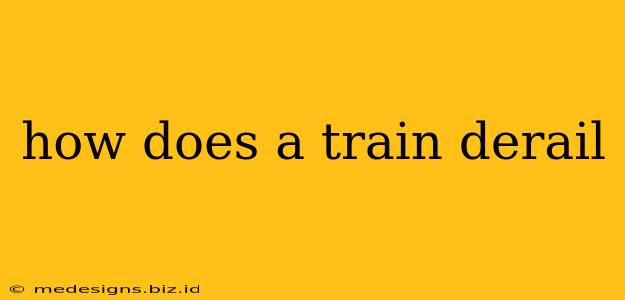How Does a Train Derail? Understanding the Causes of Train Accidents
Train derailments, while thankfully relatively rare considering the vast number of miles trains travel daily, can have devastating consequences. Understanding the causes is crucial for preventing future incidents. This article delves into the various factors that can lead to a train derailment, from human error to track issues and beyond.
Human Error: A Significant Contributing Factor
Human error accounts for a significant portion of train derailments. This includes:
- Improper track maintenance: Insufficient or negligent track maintenance, such as failing to properly address track defects or delayed repairs, can lead to derailments. This includes issues with track gauge, alignment, and surface irregularities.
- Signal failures: Malfunctioning signals or incorrect signal indications can confuse engineers, leading to accidents. Signal system maintenance and timely repairs are crucial to prevent such failures.
- Operator error: Engineer fatigue, inattention, exceeding speed limits, or improper handling of the train itself can all directly contribute to a derailment. Stricter regulations and improved training are essential to mitigate this risk.
- Poor communication: Breakdowns in communication between train crews, dispatchers, and maintenance personnel can create hazardous situations leading to derailments. Improved communication systems and clear protocols are vital.
Track Issues: The Foundation of Safe Rail Travel
The condition of the railway track itself plays a critical role in preventing derailments. Several track-related factors contribute:
- Track defects: These can include broken rails, worn-out sleepers (ties), washed-out ballast, and track settling. Regular inspections and prompt repairs are crucial.
- Track geometry: Improper track alignment or gauge (the distance between the rails) can cause trains to derail. This highlights the importance of precise track laying and ongoing maintenance.
- Environmental factors: Extreme weather conditions such as flooding, earthquakes, and landslides can damage tracks and cause derailments. Effective monitoring systems and emergency response plans are vital in these instances.
Rolling Stock Problems: Equipment Malfunctions
Problems with the train cars themselves can also cause derailments:
- Wheel defects: Flat wheels, broken axles, or worn-out bearings can lead to derailment. Rigorous inspection and maintenance schedules are essential.
- Coupler failure: Failures in the couplers that connect the train cars can cause cars to separate and derail. Regular coupler inspections and replacement are vital.
- Brake system failures: Malfunctioning brakes can cause a train to lose control, potentially leading to a derailment. Routine brake inspections and maintenance are crucial.
Sabotage and Other External Factors
While less common, acts of sabotage or other external forces can also cause derailments. This emphasizes the need for robust security measures and surveillance systems.
Conclusion: A Multifaceted Problem Requiring a Multifaceted Solution
Train derailments are complex events, rarely attributable to a single cause. Preventing them requires a multifaceted approach involving:
- Stricter safety regulations and enforcement: Ensuring compliance with established standards is paramount.
- Improved technology and infrastructure: Investing in modern signaling systems, track monitoring, and maintenance technologies is crucial.
- Enhanced training and education: Providing comprehensive training to train operators, maintenance personnel, and other stakeholders is key.
- Stronger communication and coordination: Effective communication between all parties involved in rail operations is vital.
By addressing these various aspects, the railway industry can significantly reduce the risk of train derailments and ensure the safety of passengers and freight.
